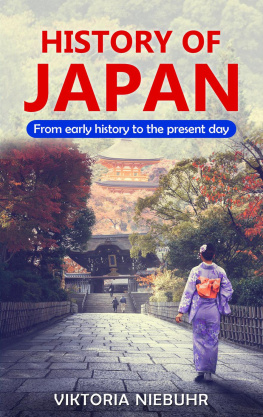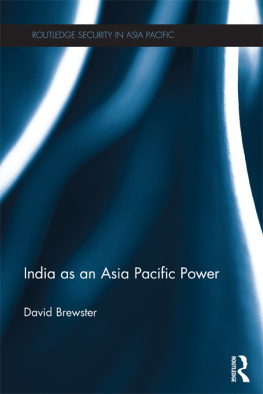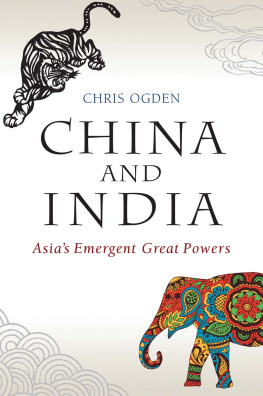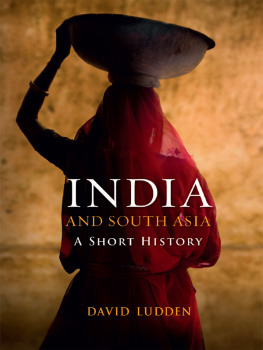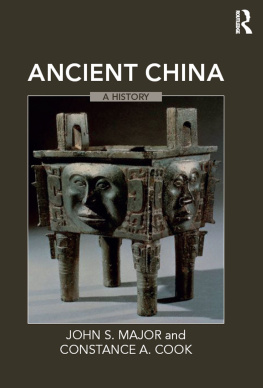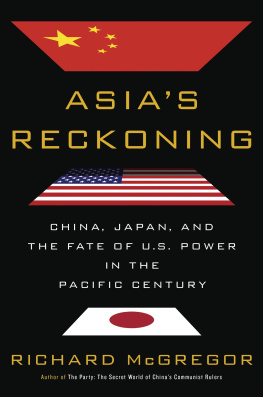HISTORYOFASIA
From Early Times to the Present
B.V. Rao
NEW DAWN PRESS, INC.UK USA INDIA
DedicationThis book is dedicated to my motherLate BELDONA SITA BAI
NEW DAWN PRESS GROUP
Published by New Dawn Press Group
New Dawn Press, Inc., 244 South Randall Rd # 90, Elgin, IL 60123e-mail: sales@newdawnpress.com
New Dawn Press, 2 Tintern Close, Slough, Berkshire, SL1-2TB, UKe-mail: salesuk@newdawnpress.org
New Dawn Press (An Imprint of Sterling Publishers (P) Ltd)A-59, Okhla Industrial Area, Phase-II, New Delhi-110020, Indiae-mail: info@sterlingpublishers.com
www.sterlingpublishers.com
History of Asia: From Early Times to the Present2005, B.V. Rao
ISBN 1 932705 36 8 (PB)ISBN 1 932705 47 3 (HB)
All rights are reserved. No part of this publication may bereproduced, stored in a retrieval system or transmitted, in any form orby any means, mechanical, photocopying, recording or otherwise,without prior written permission of the publisher.
P RINTED IN I NDIA
CONTENTS
Preface to the Second Editionxiv
Preface to the First Editionxv
P ART I
EAST ASIA1.Early and Medieval China3Introduction. Dynastic and Cultural History: Shi-Huang Ti, The HanEmperor Wu Ti, Silk Route. The Tang Dynasty: Enlightened Emperor.The Sung Dynasty. Neo-Confucianism. Rapid Growth of MoneyEconomy. Mongol Conquest of China ( AD 1211-1348). The MingDynasty. Political Ideas and Institutions in China: Chinese Laws, GeneralAdministration, The Civil Service.
2.The Advent of Europeans13Sino-Russian Relations. The Canton Trade. The Opium Wars in China.The Terms of the Treaty of Nanking. The Second Opium War. AngloFrench Joint Expedition. Why Were Rebellions So Common in China?
3.The Taiping Rebellion (1850-1864)21
Modern Reforms of Hung. Significance of the Rebellion.
4.Dismemberment of China25
The Tung Chih Restoration. Chinas Foreign Relations. The MaritimeCustoms Service. Arsenals and Shipyards: Chinese Response to theChristian Missions. The Tientsin Massacre. Further Inroads into ChineseSovereignty. The Chinese Turkestan. The French Conquer Indo-China.The Sino-French War. Spheres of Influence; Cutting of the ChineseMelon.
5.Boxer Rebellion (1900)36
The Boxer Movement (Xenophobic). Governments Clandestine Supportto Boxer Movement. The Course of Boxer Movement. ForeignInterference. The Boxer Protocol. The Open Door Policy. The Shapingof the Open Door Policy. Reforms of Empress Dowager. Military Reforms.Administrative Reforms. Constitutional Reforms.
viHistory of Asia6.The Outbreak of Chinese Revolution (1911)45
Comparative Lack of Industrialisation. Agitation over RailroadConstruction. Sun Yat Sen and the Chinese Revolution of 1911. Life ofSun Yat Sen (1866-1925). Yuans Phantom Republic. SeparatistMovements. Dollar Diplomacy. The Era of Warlords. Social Change.The May Fourth Movement (1919). The Support of the Soviet Union.Chiang Kai Shek. Chiang and His Nationalist Government. Relationswith Foreign Powers. Negotiations for New Treaties. Consolidation ofthe Nationalist Government. Chinese Economy under the NationalistGovernment. Chiang and the Communists.
7.The Rise of Communist China58Life-sketch of Mao. Nationalist Army Fails to Conquer Rebel Bases.The Long March (1934-35). The Work of the Communists During theYenan Period. Japanese Invasion of Manchuria. United Front againstJapan. The Course of the Sino-Japanese War. Rivalry between CCP andJapan. The Course of the Sino-Japanese War. Rivalry between CCP and49). Causes of Communist Victory.
8.Communist China67Details of Administrative Set-up. The New Constitution (1954). PartyPropaganda. Communist Indoctrination. Elimination of Feudal Elements.Economic Reconstruction. Industrial Progress. InfrastructureDevelopment. The Commune System. Social Change. The ChineseEducational System. Great Leap Forward (1957-59). Cultural Revolution(1966-69). Chinas Foreign Policy under Mao. Sino-American Relations.Chinas Relations with Asiatic Countries. Sino-Soviet Relations. MaosLegacy. Deng Xiaoping. His Contribution. The Tiananmen SquareTragedy. Chinas Economic Growth. Foreign Relations. Macao.
9.The Opening of Japan83The Heian Period ( AD 794-1185). Hojos Administration. AshikagaShogunate. The Japanese Feudal Society. Commodore Perrys Visit.Treaties with Other Powers. The Harris Treaty. Fall of the Shogunate.
10.The Meiji Revolution90The New Political System. Abolition of Feudalism. Educational Reforms.Economic Development. Industrial Progress. The New Constitution(1889). Political Parties. Further Economic Growth.
11.Conflicts in East Asia97Koreas Contact with the West. Prelude to Sino-Japanese War. TientsinConvention. Causes of Sino-Japanese War (1894-95). Immediate Cause.Course of the War. Terms of the Treaty (17 April 1895). The Aftermath.
Contentsvii12.The Rise of Japanese Imperialism103
Sino-Russian Agreements. The Anglo-Japanese Alliance (1902).
Sino-Russian Agreements. The Anglo-Japanese Alliance (1902).05). Terms of the Treaty of Portsmouth. Significance of the Treaty. Japanand Manchuria. Sino-Japanese Treaty (December 22, 1905). Annexationof Korea (1910). Japans Entry into the Great War. The Twenty-oneDemands (May 1915).
13.Japan and the Washington Conference111The Four Power Pacific Treaty. The Five Power Treaty (Naval ArmamentLimitation). The Nine Power Treaty. Chinas Demands.
14.Rise and Fall of Party Governments in Japan116Cabinet Governments. The Minseito Cabinet (1929-31). JapaneseMilitarism. Failure of the Party Government. Fascist Dictatorship.
15.Japanese Imperialism and the Second World War122The Mukden Incident. The Chinese Protest. The Manchuko State. TheResults of the Conquest of Manchuria. The Establishment of ParallelNationalist Government. Diplomatic and Military Offensives by Japan.Pearl Harbour Attack. The Conquest of South-East Asia. The AlliedPreparations for War and Peace. The Allied Offensives in the Asia-Pacific.End of Unequal Treaties.
16.The Post-war Japan130The Role of the United States. Demilitarisation of Japan and War Trials.The New Constitution. Educational Reforms. Social Change. GrowingUrbanisation. The Destruction of the Zaibatsu. Economic Scene. JapaneseCoalition Politics. Keizo Obuchi, the New PM. Foreign Relations(1952-2004).
17.South and North Korea, Hong Kong and Taiwan139Early History. Modern History. Rise of Nationalism. The Korean War(1950-53). South Korea: Rhee and his Successors, An Asian Tiger. NorthKorea: North-South Unification. Hong Kong: Economic Development,Hong Kongs Transfer. Taiwan: Fastest Growing Economy, Taiwan Today.
P ART II
SOUTH-EAST ASIA18. Burma (Myanmar)151Introduction (Geographical Setting). Early Migrations to Burma. TheToungoo Dynasty ( AD 1531-1732). The Konbaung Dynasty (1752-1885).The British Conquest of Burma: First Burmese War (1824-26), SecondBurmese War (1852). Third Burmese War. Origins of the Burmese
viii
History of AsiaNational Movement: Burmese National Movement. The JapaneseOccupation of Burma. Burmese Independence. Post-Independence Era:Repression Continues.
19. Thailand (Siam)1651651317). Ramadhipati (1350-69). Trailok (1448-88). Centralisation ofGovernment and Administration. Early Contacts with the West. Rama I(1782-1809). Revision of the Code of Laws. King Mangkhut: ForeignRelations, Modernisation. King Chulalongkorn (1868-1910): ForeignRelations. Rama VII (Prajadhipok). The Bloodless Revolution of 1932.Militant Nationalism. Alliance between Thailand and Japan (1940). TheFall of Phibuns Government. Peace Settlement. The Post-war Period.Political Instability. The Coup of 1957. Thailand Involved in VietnamWar. Students Revolt, (1973). Military Coups. Monarchy Respected.Recession (1997-2001)



